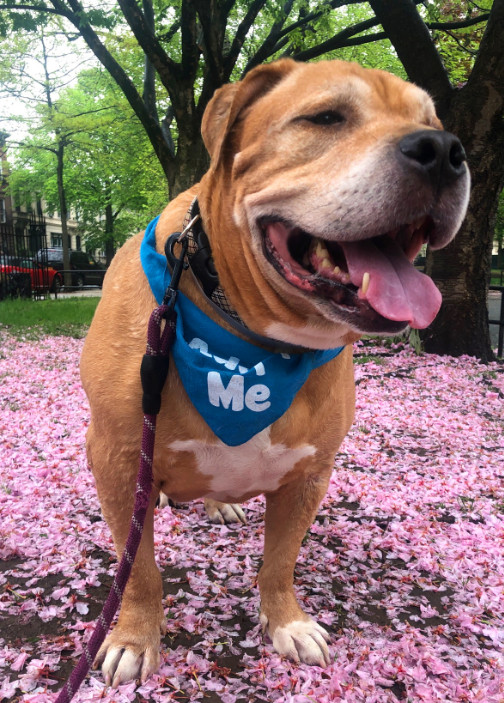
10 Things
Every Dog Foster
Needs to Know
10 Things Every Dog Foster
Needs to Know
So you have a foster dog.
Now what?
During these crazy coronavirus days, animal lovers across the country have stepped up to foster dogs and ease the burden on shelters and rescues.
If you are one of these caring individuals — thank you! May your foster dog bring you comfort and joy in these scary times.
Rescue dogs often come with unique challenges and needs, so whether you are an experienced dog owner or if this is your first dog, here are some straightforward tips about fostering a dog.
So you have a foster dog. Now what?
During these crazy coronavirus days, animal lovers across the country have stepped up to foster dogs and ease the burden on shelters and rescues.
If you are one of these caring individuals — thank you! May your foster dog bring you comfort and joy in these scary times.
Rescue dogs often come with unique challenges and needs, so whether you are an experienced dog owner or if this is your first dog, here are some straightforward tips about fostering a dog.
- Clean, fresh water should always available.
- Dog food: Don’t overthink it. Buy a quality brand and follow the feeding directions on the bag. Many pet food stores offer delivery. Some shelters provide food, but consider purchasing it yourself, as most rescues operate on a shoe-string budget.
- Collar with ID Tags and a Leash: Dogs directly from the shelter are a high flight risk. Your foster should always wear a collar and a tag (even when at home) with contact information in case they escape. Leash your dog whenever the front door opens to prevent bolting. Consider a Martingale collar, which dogs cannot back out of. Do not let your foster off-leash when on walks! If your dog pulls on walks, try a front clip harness.
- Dog bed: Depending on your foster and how you feel about dogs on the furniture, a dog bed may be optional. Dog beds can be pricey, and your foster might decide that the couch is comfier.
- Treats: Pet stores sell every imaginable dog treat, but most dogs are quite happy with plain boiled chicken, string cheese, or sliced turkey meat.
- Vinegar or enzyme cleaner: many fosters will have accidents the first day or two.
- Fostering expenses are tax-deductible if you are working with a not-for-profit (501c3) rescue. Save your receipts and check with your tax preparer.
- Get a crate, x-pen, or baby gates: If you have a puppy or are struggling with potty training (see below) or have a young dog that chews everything, consider crate training or confining to a smaller area when you cannot directly monitor them. Crates are also a good option for shy dogs that need a quiet, safe space. Never shove a dog straight into a crate; follow these steps to crate train properly.
- Check your house for common house and backyard plants that are poisonous to dogs.
- Keep foods that are poisonous to dogs out of their reach.
- Stash your stash: marijuana is highly toxic to dogs.
- Read the shelter’s foster contract before taking a dog home so you know what your responsibilities are.
- Make sure you have shelter phone number(s) and vet contacts in case your foster becomes sick, runs away, or exhibits extreme behaviors.
- Most rescues request prior authorization before any vet trips. Find out in advance who to call and what to do in an emergency during off-hours.
Fostering can sometimes be a challenge, but you are not expected nor obligated to keep a dog that is potentially unsafe in your home. If you have safety concerns about your new foster involving your children or other pets, know that you can and should return the dog without any shame or guilt. There will be a better household for that particular dog and a different dog for you to foster. Pass along any new information to include in the dog’s shelter profile (“not good with cats,” “does not like children”) so potential adopters can make an informed choice.
The dog you bring home will not be the same dog in a few weeks. It can take anywhere from a couple of weeks to a few months for your rescue dog’s personality to emerge fully. Most shelter dogs have been through a great deal of trauma: whether surrendered by a family they loved or abandoned and stray. Life in a shelter is noisy and scary, and lonely. They have no idea who you are and how they ended up at your house.
The first few days your foster may sleep a lot, appear depressed or agitated, possibly ignore al food and treats, not poop, or resist walks. All very normal. Your dog will not starve to death if they don’t eat or eat very little for the first few days: keep offering food and make sure they have access to water. It’s okay if they don’t want to go on walks or play or snuggle. Building trust takes patience and time. For shy and nervous dogs, practice asking for consent before interacting.
Your new foster dog will most likely have at least one potty accident in your house. Even dogs that were previously house-trained may forget their training due to the stress and confusion of being in a new home or because they were confined at the shelter. Consider yourself very lucky if your foster dog never has an accident. If you foster a puppy or a stray dog then plan on potty training from scratch.
- If possible, roll up all your rugs temporarily.
- Use vinegar or enzyme cleaner to clean up accidents thoroughly.
- Use a belly band (lined with incontinence pads) for male dogs that mark inside.
- Housetraining 101 (not just for puppies!)
- Keep it Force-Free: Scientific studies show that positive reinforcement dog training is more effective and successful than dominance training and punishment. Force-free training does not rely on human dominance/dog submission or the (debunked) theory of “being the pack leader.”
- Manage the environment so that your dog cannot engage in unwanted behaviors. Management is not training, but it prevents your dog from habitually practicing bad behaviors. For example, keep your dog on a leash when greeting people until she learns not to jump up. In some cases, management is the fastest fix. It’s easier to put the kitchen trash out of reach than to train your dog to ignore it.
- Keep it Fun: Training should be enjoyable for both you and your dog. If you get frustrated or your dog starts ignoring you, take a break and try again later. A few short training sessions (2–5 minutes) throughout the day is better than a large chunk of time.
Now is a great time to foster because we are all at home. Your foster dog should get used to being left alone because eventually most of us will head back to work. Here are some things you can do to prepare your foster for life after the pandemic.
- When leaving and returning home, don’t turn it into a big production. Keep it low-key and drama-free.
- Practice leaving your foster alone for short amounts of time, varying and slowly increasing the amount of time you are away.
- Before leaving the house, set up a camera (or a zoom meeting on your laptop), and watch from outside the closed door. If your foster show signs of distress, come back inside before panic sets in.
- Understand that you can't cause or prevent separation anxiety. If you suspect your foster has this anxiety disorder, let the rescue know and educate yourself.
Fostering gets dogs out of cages and frees up space for other surrendered or abandoned animals. But the ultimate goal is to find a permanent home for every dog that goes into foster. Help your foster find their forever home by:
- Posting pictures, videos, and updates about your foster on social media and asking friends to share your posts.
- Have your dog wear an “adopt me” vest or bandana on walks.
- Send pictures and updates to the shelter so they can keep the dog’s profile current.
- Prepare to be emotional and possibly conflicted when your foster gets adopted. Saying goodbye can be heartbreakingly bittersweet. Know that you have made a difference and saved the life of a homeless dog. Then get another foster.

You may fall madly in love with your foster dog and decide they are the perfect match for you and your family.
Congratulations — you are a foster fail. Everyone wins!

